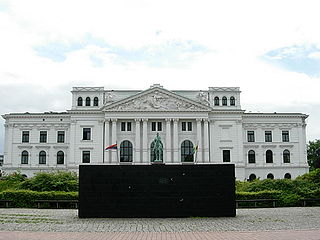
Adelaide Railway Station is the central terminus of the Adelaide Metro railway system. All lines approach the station from the west, and it is a terminal station with no through lines, with most of the traffic on the metropolitan network either departing or terminating here. It has nine platforms, all using broad gauge track. It is located on the north side of North Terrace, west of Parliament House. The Adelaide Casino occupies part of the building that is no longer required for railway use. Until 1984, Adelaide station was also the terminus for regional and interstate passenger trains, but there are no longer any regular regional train services in South Australia, and all interstate services are now handled at Adelaide Parklands Terminal.

The rail network in Adelaide, South Australia, consists of six lines and 89 stations, totalling 125.9 km. It is operated by Adelaide Metro, and is part of the citywide Adelaide Metro public transport system.

August Ludwig Christian Kavel. Pastor Kavel was a founder of Lutheranism in Australia.

German settlement in Australia began in large numbers in 1838, with the arrival of immigrants from Prussia to Adelaide, South Australia. German immigrants became prominent in settling South Australia and Queensland. From 1850 until World War I, German settlers and their descendants comprised the largest non-British or Irish group of Europeans in Australia.

Bethany is a small village about 2 km south-east of Tanunda in the Barossa Valley. It was originally named Bethanien, but was changed during World War I in an attempt to remove all German place names from Australia. Similarly, the German-language school was forced to close by the state government in 1917, with 60 students at the time.

Outer Harbor is a suburb in the Australian state of South Australia located at the northern tip of the Lefevre Peninsula about 22 kilometres (14 mi) north-west of the Adelaide city centre.

City of Adelaide is a clipper ship, built in Sunderland, England, and launched on 7 May 1864. The ship was commissioned in the Royal Navy as HMS Carrick between 1923 and 1948 and, after decommissioning, was known as Carrick until 2001. At a conference convened by HRH The Duke of Edinburgh in 2001, the decision was made to revert the ship's name to City of Adelaide, and the duke formally renamed her at a ceremony in 2013.

Australian rules football in South Australia has a history dating back to the early 1860s, and it has long been the most popular sport in the state.

Klemzig is a suburb of Adelaide in the City of Port Adelaide Enfield. It was the first settlement of German immigrants in Australia and was named after the village of Klemzig, near Züllichau in southeastern Brandenburg in the German state of Prussia, where they originated from. That Klemzig is now in western Poland and is now known by the Polish name Klępsk.

Port Lincoln Airport is an airport serving Port Lincoln, a city in the Australian state of South Australia. It is located 7 nautical miles north of Port Lincoln, at North Shields. The airport is owned and operated by the District Council of Lower Eyre Peninsula. It was the second busiest airport in South Australia during 2009/10, with 168,147 passengers served.

Moana is an outer coastal suburb in the south of Adelaide, South Australia. The suburb is approximately 36.4 km from the Adelaide city centre. It lies within the City of Onkaparinga local government area, and neighbours the suburbs Seaford, Maslin Beach, Seaford Rise and Port Noarlunga
John Lazar was an actor and theatre manager in Australia. He was Mayor of Adelaide from 1855 to 1858.

James Stokes Millner MD was a medical practitioner and administrator in the early history of the Northern Territory of Australia.
William McMinn was an Australian surveyor and architect, based in Adelaide.
The Royal Agricultural and Horticultural Society of South Australia was founded in November 1839 as the South Australian Agricultural Society with the aim of promoting primary industries in the Colony. The Society and its functions were patterned on similar organisations in England, and in its successive incarnations, the organisation has continued to pursue this aim to the current day.

Angelo Nicholas Goucar Congear was an Australian rules footballer who played for the Port Adelaide Football Club in the South Australian National Football League between 1908 and 1922.
Rapid was the brig that brought William Light's surveying party to the new colony of South Australia. She was wrecked in 1841.

The New Zealand Company was a 19th-century English company that played a key role in the colonisation of New Zealand. The company was formed to carry out the principles of systematic colonisation devised by Edward Gibbon Wakefield, who envisaged the creation of a new-model English society in the southern hemisphere. Under Wakefield's model, the colony would attract capitalists who would then have a ready supply of labour—migrant labourers who could not initially afford to be property owners, but who would have the expectation of one day buying land with their savings.
Agincourt was launched at Sunderland in 1844. She immediately transported convicts to Norfolk Island. Thereafter she traded widely, sailing to Australia, Aden, and South America. Her homeport changed to Spain at some point prior to 1870 and thereafter Lloyd's Register carried stale data until it ceased listing her in 1886.
















